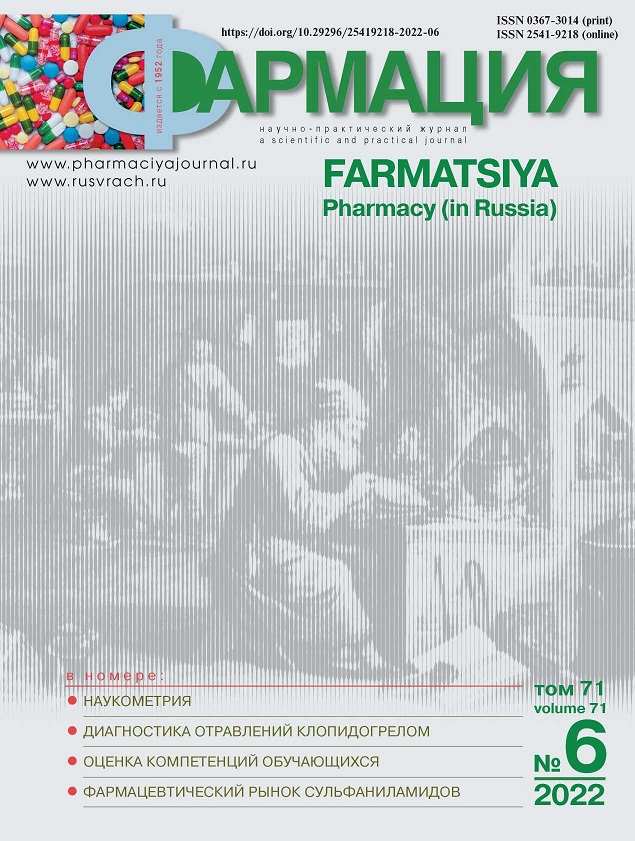Polymorph screening and study of the structure of crystalline forms of phenyltetrahydroquinolinedione derivative with TRPA1-antagonistic activity
- Authors: Pyatigorskaya N.V.1, Nikolenko N.S.1, Kravchenko A.D.1, Nesterkina E.I.1
-
Affiliations:
- The State Education Institution of Higher Professional Training The First Sechenov Moscow State Medical University under Ministry of Health of the Russian Federation
- Issue: Vol 71, No 6 (2022)
- Pages: 27-33
- Section: Technology of medicines
- URL: https://journals.eco-vector.com/0367-3014/article/view/113768
- DOI: https://doi.org/10.29296/25419218-2022-06-04
- ID: 113768
Cite item
Abstract
Introduction. 7-(2-chlorophenyl)-4-(4-methyl-1,3-thiazol-5-yl)-4,6,7,8-tetrahydroquinoline-2,5(1H,3H)-dione is a new selective TRPA1 antagonist, which can become a promising analgesic and anti-inflammatory drug of a new generation. To develop its solid dosage form, it is necessary to determine its characteristics that can affect the critical quality attributes of the final product. Polymorphic modification of an active substance is one of these parameters. Objective: to screen for phenyltetrahydroquinolinedione derivative polymorphs and to study their structure using diffraction methods of analysis. Material and methods. X-ray powder diffraction was carried out on a Bruker D8 Discover diffractometer equipped with a nickel filter and a position-sensitive detector. The calculations were carried out using the DIFFRAC.SUITE EVA and TOPAS 4.2 software. The survey was carried out using the Bragg-Brentano geometry, in the reflection mode. Single crystals of polymorphic modifications were obtained by crystallization from various organic solvents and their mixtures. X-ray diffraction analysis was performed on a single-crystal X-ray diffractometer Xcalibur-3. Single-crystal structures were deciphered by a direct method using the SHELXTL software package. Results. The results of X-ray powder diffraction showed the presence of several crystalline phases in the native API sample; however, the results did not allow us to identify specific polymorphs. As a result of polymorph screening, several single crystals suitable for X-ray diffraction analysis were obtained from various solvents. The evaluation of the obtained samples showed no differences in the solubility of the polymorphs. It was found that orthorhombic modification I crystallizes from ethanol, while triclinic modification II crystallizes from methanol, isopropanol, acetone, acetone/acetonitrile or THF/acetonitrile mixtures. Differences in the molecular structure of the resulting polymorphs and their packing in crystals have been described. Conclusion. The identified API polymorphic modifications can be further evaluated in order to select a polymorph for the development of a solid dosage form based on it.
Keywords
Full Text
About the authors
Natalia Valeryevna Pyatigorskaya
The State Education Institution of Higher Professional Training The First Sechenov Moscow State Medical University under Ministry of Health of the Russian Federation
Author for correspondence.
Email: pyatigorskaya_n_v@staff.sechenov.ru
Doctor Habil. of Sciences of Pharmacy, Professor, Deputy Director of the Institute of Translational Medicine and Biotechnology, Head of the Department of Industrial Pharmacy, Institute of Vocational Education, Corresponding Member of the RAS
Natalia Sergeevna Nikolenko
The State Education Institution of Higher Professional Training The First Sechenov Moscow State Medical University under Ministry of Health of the Russian Federation
Email: nikolenko_n_s@staff.sechenov.ru
PhD in pharmaceutical sciences, associate professor of the Department of Industrial Pharmacy, Institute of Vocational Education.
Aleksei Dmitrievich Kravchenko
The State Education Institution of Higher Professional Training The First Sechenov Moscow State Medical University under Ministry of Health of the Russian Federation
Email: aleksej_kravchenko97@mail.ru
post-graduate student of the Department of Industrial Pharmacy, Institute of Vocational Education.
Ekaterina Igorevna Nesterkina
The State Education Institution of Higher Professional Training The First Sechenov Moscow State Medical University under Ministry of Health of the Russian Federation
Email: catherinenesterkina@gmail.com
assistant of the Department of Industrial Pharmacy, Institute of Vocational Education.
References
- Koivisto A., Jalava N., Bratty R. et al. TRPA1 Antagonists for Pain Relief. Pharmaceuticals. 2018; 11 (4): 117. doi: 10.3390/ph11040117.
- Бесхмельницына E. А., Покровский М. В., Должиков А. А. и др. Исследование анальгетической и противовоспалительной активности нового неопиоидного анальгетика на основе селективного ингибитора ионных каналов TRPA1. Кубанский научный медицинский вестник. 2019; 26 (1): 77-87.
- Singhal D. Drug polymorphism and dosage form design: a practical perspective. Advanced Drug Delivery Reviews. 2004; 56 (3): 335-47. doi: 10.1016/j.addr.2003.10.008.
- Brog J.-P., Chanez C.-L., Crochet A. et. al. Polymorphism, what it is and how to identify it: a systematic review. RSC Advances. 2013; 3 (38): 16905. doi: 10.1039/C3RA41559G.
- Censi R., Martino P.D. Polymorph Impact on the Bioavailability and Stability of Poorly Soluble Drugs. Molecules. 2015; 20 (10): 18759-76. doi: 10.3390/molecules201018759.
- Raza K. Polymorphism: The Phenomenon Affecting the Performance of Drugs. SOJ Pharmacy & Pharmaceutical Sciences. 2014; 1 (2). doi: 10.15226/2374-6866/1/1/00111.
- FDA guidance for industry. ANDAs: Pharmaceutical Solid Polymorphism: Chemistry, Manufacturing, and Controls Information. [Electronic resource]. Access mode: https://www.fda.gov/regulatory-information/search-fda-guidance-documents/andaspharmaceutical-solid-polymorphism-chemistry-manufactu-ring-and-controls-information
Supplementary files











